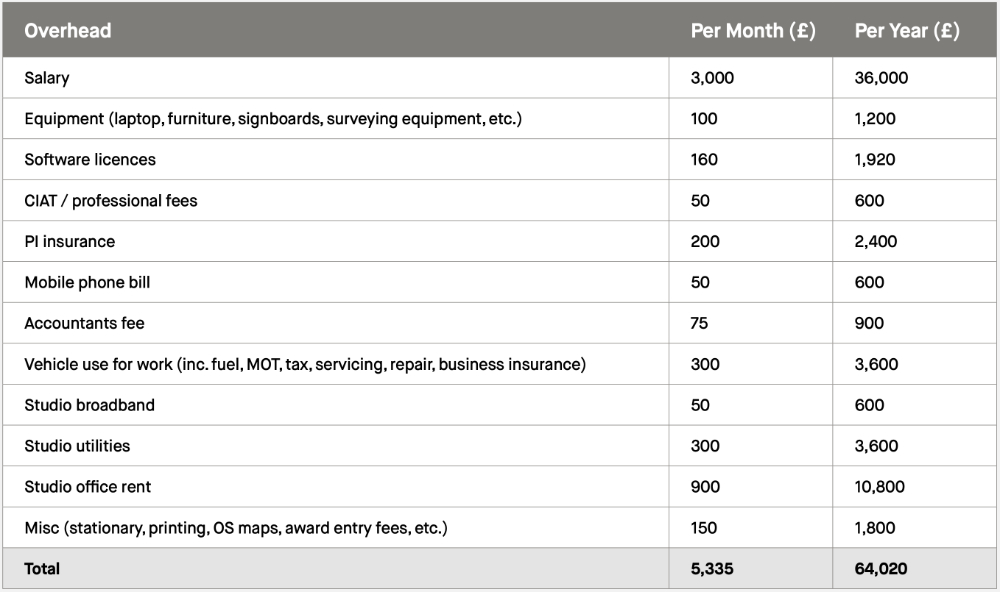Practice costs for architectural technologists
Contents |
[edit] Salary standards and working out what you’re worth
Architectural industry salary standards have been gathering a large amount of interest recently, leading to a huge awakening of public understanding of the gulf between what is charged and what is actually earned.
Publicised across the media and in industry-specific podcasts such as Jon Clayton MCIAT’s ‘Architecture Business Club’, this topic of stagnating salaries is becoming an increasingly urgent discussion. And yet, with such a huge focus on how much a Chartered Architectural Technologist earns, why are so few people asking, “How much does it cost to be a Chartered Architectural Technologist?”
To calculate the ‘break even rate’ for an architectural practice, one must first look at the overheads. There are
no universal magic numbers here; each specific practice will have its own unique set of overheads and other costs. A sole practitioner will of course have very different overhead costs to a medium sized practice in a city centre.
Below are example figures that simply show the principle of calculating overheads:
[edit] Annual Hours
To determine the hourly break-even rate, the practice will need to determine how many chargeable hours are available in a year:
37.5 Hours a week x 48 weeks equals 1,800 Hours per year. If 60% of those hours are invoiced for, that equals 1,080 hours per year. This gives us a £59.28 per- hour ‘break even rate’. (This is £79.04 per hour after 25% corporation tax.)
If we were to add a 20% profit margin, this would give the above example a chargeable rate of £94.84 per hour.
[edit] Utilisation
Wait a second... why are only 60% of hours invoiced? Well, every single worker in our industry will have a unique ‘utilisation ratio’ – the percentage of their time that is directly billable to the client. For a technologist working in a large firm who spends most of their time drawing, this may be close to 100%. However, for a Director of a mid-to-large practice, this will probably be 0% – their job is to win work and manage the company; none of which is billable.
If we take the above example of a sole practitioner Chartered Architectural Technologist who is tendering for a small domestic extension planning application, they have estimated 32 hours of their time to complete the application. However, in real hours, this could account for up to 53 hours of practice time.
[edit] Winning the project
Say a practice wins 1:3 projects that they bid for (which is better than average if a domestic client
is approaching four or five practices). It could take approximately four hours to travel to meet the potential client, travel back, produce a detailed fee quotation letter and possibly a sketch. That already equates to 12 hours unpaid... just to win a 32-hour project.
Let’s add an hour per week for CPD (required by professional body), another for expenses and accounts, another for networking and submitting to awards and competitions, and another for social media and marketing (including marketing guides like this!). Then let’s add two hours per week for admin such as project directory updates, insurance, updating T&Cs and policies, reviewing CVs, and ordering stationary. Finally, let’s take 10% of the project, so three hours, as contingency for tweaks and unexpected queries from the planner or the client.
That is already 53 hours.
And this does not even consider aspects like fielding new enquiries, scope creep, creative time, or office socials. It also assumes you have a perfectly consistent steady stream of work coming through the studio door with zero downtime. So, what can you do to maximise profitability?
[edit] Maximising profitability: initial consultations
When a Chartered Architectural Technologist gives an initial consultation, please remember you’re not
a tradesperson just there to “give a quote”. The Chartered Architectural Technologist will be offering professional advice on the design, budgets, the planning process, as well as buildability advice. You wouldn’t expect an accountant to travel to your house and give you free financial advice. As a profession, we should normalise charging a fee for this
[edit] Maximising profitability: efficiencies
Having a good set of templates is the backbone of any practice, from drawing templates to fee proposal. These documents will save employees’ time several times a day. Think about all of your regular processes and how they could be streamlined. For example, do you still have to manually log in to your banking website to check a payment, or is it automated to either send a payment notification or generate a reminder?
[edit] Maximising profitability: reducing scope creep
Do your T&Cs set out exactly how many rounds of comments the client can give? Or the level of coordination, commenting and collaboration with other consultants? Tighten up your T&Cs to focus the client and stop any scope creep before it begins.
This is a very interesting time for our industry. If we continue to invite transparent conversation about the cost of being an Architectural Technologist, we can ensure that we are charging fairly and maximising profitability.
Lee Smith has been a Chartered Architectural Technologist for 25 years and is a Director of CIAT Chartered Practice, Cambridge Architectural Design.
This article appears nin the AT Journal issue 151 Autumn 2024 as "How much does it cost to be an AT?: Salary standards and working out what you’re worth" and was written by Lee Smith FCIAT.
--CIAT
[edit] Related articles on Designing Buildings
- Appointing an architect.
- Architect.
- Architects Registration Board.
- Architecture.
- Architectural design.
- Architectural education.
- Architectural styles.
- Architectural technician.
- Architectural technologist - delineation of roles.
- Architectural training.
- Appointing consultants.
- Building design and construction fees.
- Charge-out rate.
- CIAT articles.
- Collaborative practices.
- Concept architectural design.
- Consultant team.
- Consultant team start up meeting.
- Designers.
- Design liability.
- Fees.
- Hiring an architect as a commercial client.
- Hiring an architect as a domestic client.
- Hourly rate.
- Professional appointments.
- Professional Indemnity Insurance.
- Quantity surveyor’s fees.
- Risks in fees and appointments.
- Scope of services.
- Structural engineers' fees
- The architectural profession.
- The role of architects.
Featured articles and news
Key points for construction at a glance with industry reactions.
Functionality, visibility and sustainability
The simpler approach to specification.
Architects, architecture, buildings, and inspiration in film
The close ties between makers and the movies, with our long list of suggested viewing.
SELECT three-point plan for action issued to MSPs
Call for Scottish regulation, green skills and recognition of electrotechnical industry as part of a manifesto for Scottish Parliamentary elections.
UCEM becomes the University of the Built Environment
Major milestone in its 106-year history, follows recent merger with London School of Architecture (LSE).
Professional practical experience for Architects in training
The long process to transform the nature of education and professional practical experience in the Architecture profession following recent reports.
A people-first approach to retrofit
Moving away from the destructive paradigm of fabric-first.
International Electrician Day, 10 June 2025
Celebrating the role of electrical engineers from André-Marie Amperè, today and for the future.
New guide for clients launched at Houses of Parliament
'There has never been a more important time for clients to step up and ...ask the right questions'
The impact of recycled slate tiles
Innovation across the decades.
EPC changes for existing buildings
Changes and their context as the new RdSAP methodology comes into use from 15 June.
Skills England publishes Sector skills needs assessments
Priority areas relating to the built environment highlighted and described in brief.
BSRIA HVAC Market Watch - May 2025 Edition
Heat Pump Market Outlook: Policy, Performance & Refrigerant Trends for 2025–2028.
Committing to EDI in construction with CIOB
Built Environment professional bodies deepen commitment to EDI with two new signatories: CIAT and CICES.
Government Grenfell progress report at a glance
Line by line recomendation overview, with links to more details.
An engaging and lively review of his professional life.
Sustainable heating for listed buildings
A problem that needs to be approached intelligently.
50th Golden anniversary ECA Edmundson apprentice award
Deadline for entries has been extended to Friday 27 June, so don't miss out!
CIAT at the London Festival of Architecture
Designing for Everyone: Breaking Barriers in Inclusive Architecture.
Mixed reactions to apprenticeship and skills reform 2025
A 'welcome shift' for some and a 'backwards step' for others.






























